Creamed honey
Which of these is the odd one out?
Comb honey, chunk honey, baker’s honey, creamed honey, blossom honey, borage honey, Scottish honey, honeydew honey?
Anyone?
Reserved descriptions
Honey that is for sale needs to be labelled properly.
I don’t intend to discuss the labelling regulations as, a) they may be different here in Scotland to wherever you live, b) they’re a bit of a minefield, and c) if revised this page would quickly become out of date.
However, logically, honey that is for sale needs to have a label that includes the word ‘honey’.
Makes sense so far 😉
In addition, there are a number of reserved descriptions such as comb honey, borage honey, Scottish honey that are allowed.
These reserved descriptions may be only used ‘where the product meets the definition’.
So, you can only use the words ‘comb honey‘ when the honey is sold wholly or partly in the comb. You can only use the reserved description ‘borage honey‘ if the honey is primarily made from nectar collected from borage etc.
Similarly, the honey must be collected entirely within a certain geographic area to be named after the area.
The odd one out is ‘creamed honey‘.
My understanding is that this used to be allowed {{1}} but is no longer an acceptable reserved description. It’s certainly not listed as such on the Trading Standards website {{2}}.
It’s no longer acceptable because honey doesn’t contain cream.
Creamed honey
I think this is disappointing … after all, creamed honey never contained cream as far as I’m aware.
Instead the description was meant to indicate the smooth consistency of the product, the ‘melt on your tongue’ creamy texture.
Why should food names and labels be literal? After all, we eat hot dogs and sweetbreads {{3}}.
When I last checked these weren’t made from dogs … or bread {{4}}.
But it was clearly too confusing for some, so – inevitably – the word ‘creamed’ was banned from use as a reserved description on honey labels 🙁
But creamed has another meaning.
The Oxford English Dictionary includes the following definition of ‘creamed’ …
To deal with vigorously and with success, esp. to beat or thrash; to defeat heavily, as in sporting contexts; to ruin or wreck (a motor vehicle, etc.). colloquial (originally U.S.).
… the usage of which dates back to 1929.
And this is a perfect description of an easy way to produce a really high quality honey from coarse- and fast-granulating nectars like oil seed rape.
Oil seed rape (OSR)
For many beekeepers OSR provides a bumper early season honey harvest. The honey is extracted in late May or early June, allowed to set and then processed for sale.
Anyone who has bees near OSR will know that the honey, without processing, is spoonbendingly {{5}} hard.
To make it spreadable (and saleable) I usually use a version of the Dyce method for producing soft set honey.
Frankly, this is a bit of a palaver {{6}}.
Soft set honey
You need to completely melt the honey, cool it to 34°C, seed it with a honey with a suitable fine crystal structure, mix it thoroughly and then allow it to set at ~13°C with very regular stirring.
This whole process takes several days.
It’s not constant work and it’s not particularly hard work, but it is all a bit protracted. Done properly it produces honey with a good texture that sells well … and is outstanding on crumpets.
There are other ways of achieving this … such as buying an automated machine which does all the intermittent stirring for you.
At a price … perhaps £2500 with full temperature control.
But I don’t want to produce 50 or 100 kg of honey at a time. And I don’t want yet another piece of equipment sitting around taking up valuable space.
Like the majority of the 45,000 beekeepers in the UK, I produce nothing like the quantities of honey to justify this commercial-scale equipment.
And, like the majority of those 45,000 beekeepers, I don’t want to spend all of my time producing honey to pay for this sort of equipment. I want to rear some queens, walk in the hills, go sailing or drink coffee on the patio.
Frosting in soft set honey
Furthermore, in my experience soft set honey can show significant batch-to-batch variation in terms of its tendency to develop frosting in the jar. Some batches never show frosting, others develop the unsightly appearance (that has no influence on the flavour) within a week or two.
In my experience, I and third party sellers are more concerned about the unsightly appearance than the customers are.
I want to produce a honey that tastes and looks good.
The shopkeeper wants a honey that they know is going to sell well.
It’s not entirely clear to me what causes frosting. Some has the distribution and appearance that suggests minute bubbles have risen through the honey, getting trapped under the shoulders of the jar.
At other times it looks as though the honey has contracted slightly, pulling away from the sidewalls of the jar.
The example above is particularly unsightly and looks very like the honey is re-crystallising again, losing the ‘melt on your tongue’ crystal structure for something altogether coarser. Whatever, they went back to the furthest recesses of the cupboard where I found them 😉
Creaming honey
There’s another way to generate a fine crystal structure from a coarsely crystallised honey.
You cream it … in the OED sense of the word:
You vigorously beat it …
Which neatly brings me to the Rapido / Rasant Honey Creamer.
A few months ago Calum – who regularly submits insightful comments to posts on this site – recommended this honey creamer for processing oil seed rape honey (OSR). Calum called it the Rapido. It’s produced by Germerott Bienentechnik and they appear to call it the ‘Rasant‘ (and have what looks like a second variant available since I purchased mine).
The Rapido is a stainless steel paddle that is used to vigorously beat the honey. It’s about 9 cm in diameter and is securely mounted on a 60 cm shaft. The non-honey end of the shaft is hexagonal and can therefore be secured in the chuck of a powerful drill.
The instructions indicated a 1000 W drill was required, or – with a different fitting at the non-honey end of the shaft – you can use a plasterers mixer {{7}}.
And it works a treat:
This is a 30 lb bucket of honey converted from coarsely crystallised to a beautifully fine crystal structure in a little under four minutes.
Usage
It’s not quite as quick as I’ve described as you still need to pre-warm the honey and allow time for it to settle.
Here’s the full process I’ve used for about four buckets (~60 kg) of OSR honey in the last month.
- Warm the bucket in a honey warming cabinet at 30-33°C. It must be warmed right through, so leave for at least 12-15 hours.
- Remove any surface scum if there is any. The majority of my buckets don’t have any, so this can be skipped. My set OSR honey has already been through a coarse and fine stainless steel filters during extraction.
- Starting slowly as shown above, mix with the Rapido. Make sure all the honey is mixed, which may involve pushing the non-rotating paddle down the sidewalls of the bucket to loosen it slightly {{8}}.
- Continue mixing for 3-4 minutes until the honey is the consistency shown at the end of the video.
- Pour into a bucket with tap.
- Return to the honey warming cabinet at 30-33°C for a further 12-15 hours to allow bubbles to settle out (or is that rise out?). I’m not certain this stage is needed … but since it involves me doing nothing it’s easy to do.
- Jar the honey.
- Allow to cool. Add labels.
- Sell the honey and wait for the plaudits and repeat custom 🙂 It will happen.
Once the resulting honey cools it has a wonderful texture – easy to spoon and spread, but does not drip off the spoon.
Just perfect for crumpets or homemade bread 🙂
This really is honey that has been ‘creamed’ … beaten vigorously and with success.
I’d like to end with a “big shout out” (as the young people say) to Calum for the recommendation in the first place.
Thanks mate 🙂
Notes
A shorter post than usual this week as I’m moving house {{9}}. I’m writing this when I should be packing boxes … or trying to find things I now need that were packed into boxes yesterday. Assuming things have gone to plan I’m no longer a permanent resident of Fife (though I’ll continue to work there) and now live in the wild west 🙂
Germerott Bienentechnik don’t have a UK distributor for the Rasant honey creamer (I know, because I’ve chatted with them about it) so it needs to be purchased direct from Germany. It costs ~€50 but is quite heavy so shipping costs are high. Post-Brexit there may also be additional taxes involved 🙁
UPDATE (23/2/21) As indicated in the comments below, Thorne’s now appear to be selling this as a honey churner … at least it looks identical to me. I’ve also been in contact with Werner and Klaus at Bienentechnik and they are happy to take your order and can be contacted on info@bienentechnik.com. Inevitably, there may be some post-Brexit shipping issues to overcome 🙁
Finally, there’s always a demand for raw honey. Although I still wouldn’t call this honey ‘raw‘, I can claim honestly that it’s not been heated to temperatures higher than would naturally occur in the hive. Some customers will prefer this.
{{1}}: Or was widely used, perhaps before reserved descriptions were introduced.
{{2}}: Interestingly, label manufacturers still sell “Creamed (or sometimes cremed) honey” labels that can be used in addition to the front label on the jar where the reserved description, or just the word honey is printed.
{{3}}: And what about spotted dick or Rocky Mountain oysters for goodness sake?!
{{4}}: Those in the know will be well aware that Rocky Mountain oysters are nothing to do with shellfish … and good luck to those brave enough to search for spotted dick on the internet.
{{5}}: For overseas readers be warned that spoonbendingly is not a real word. It should be.
{{6}}: Colloquial (chiefly West African). Trouble, difficulty; bother, ‘hassle’.
{{7}}: Don’t bother trying to use a cordless drill or an underpowered corded drill … you will burn it out. My 650 W drill struggled and I purchased a 1010 W one that is now dedicated for creamed honey production.
{{8}}: The instructions make it clear that the whirling paddle should not come into contact with sidewall of the bucket – presumably to avoid filling the honey with thousands of plastic scrapings or shards.
{{9}}: Though not that much shorter … it’s still longer than the average post just 3 years ago.
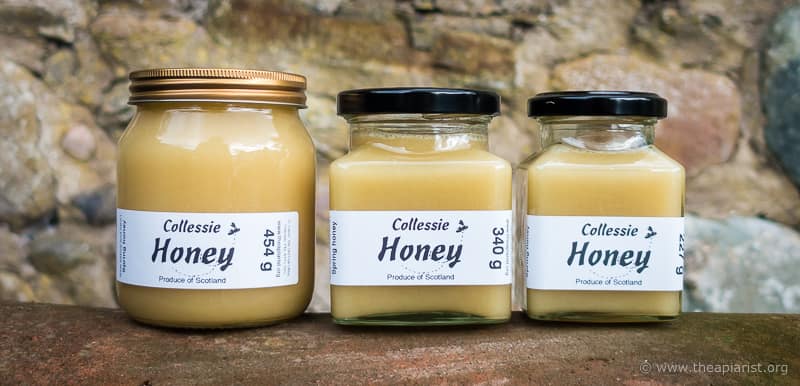
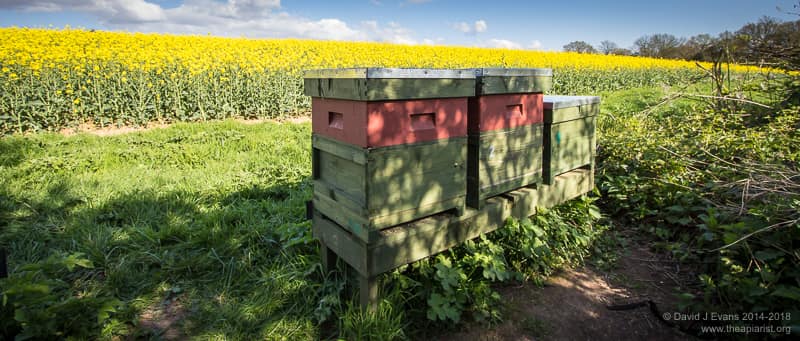
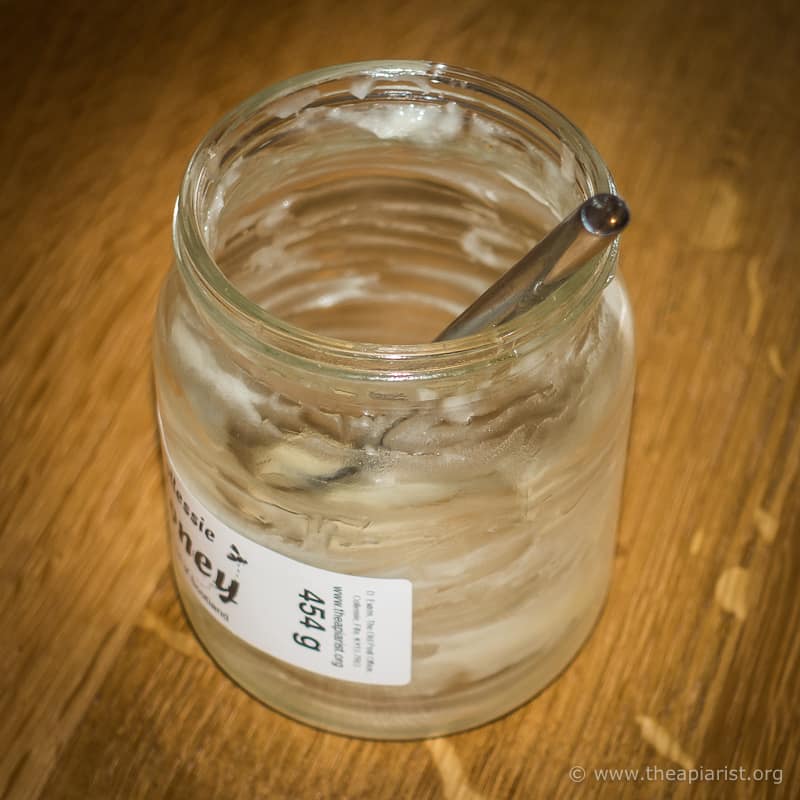
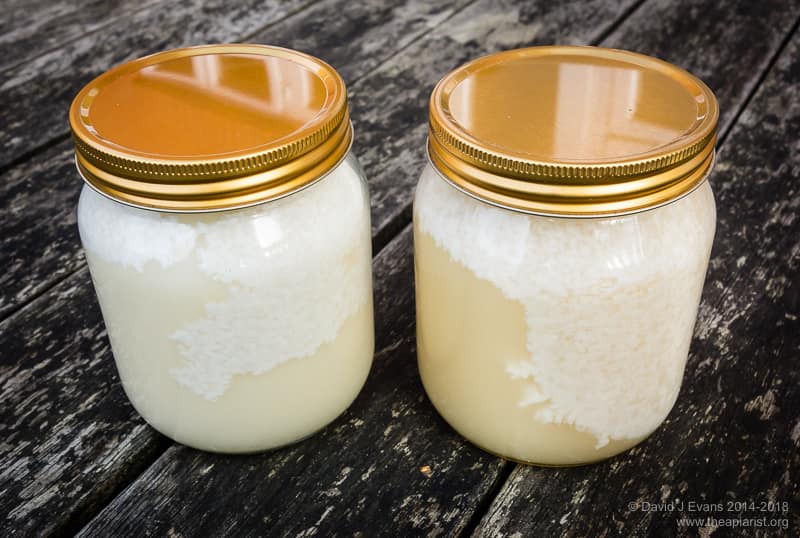
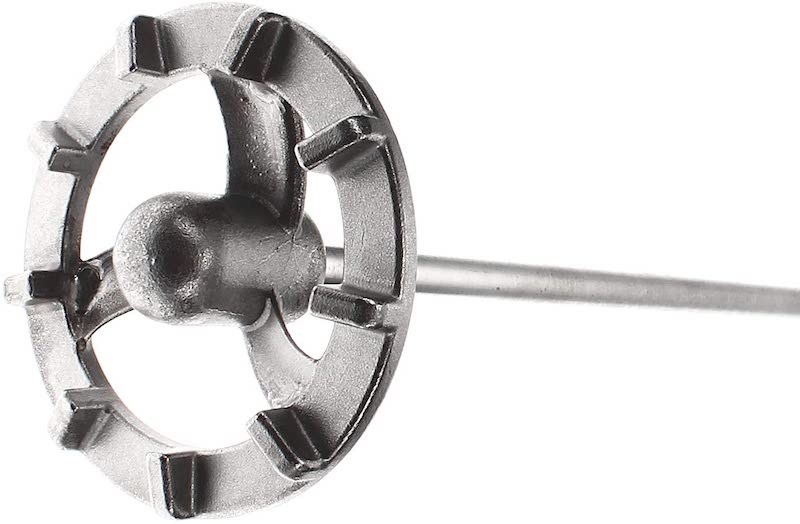
Join the discussion ...